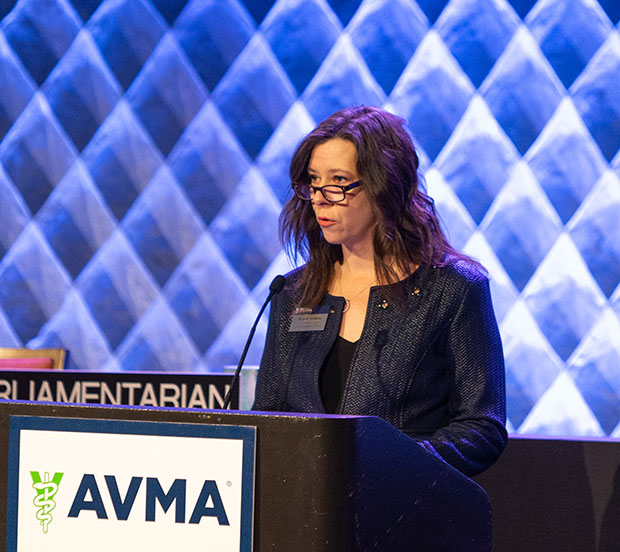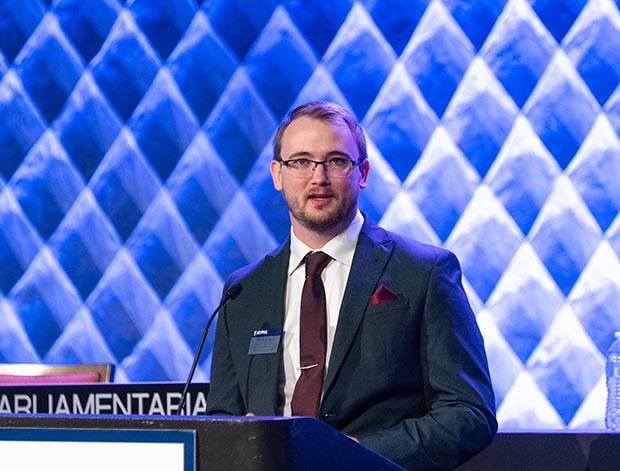According to a recent AVMA survey of members, 40% said they or someone they work with has been a victim of cyberbullying in the workplace. Further, cyberbullying for companion animal veterinarians has increased nearly 20% since 2014. More than 50% of respondents said cyberbullying had an impact on their mental health, and 47% said cyberbullying contributed to workplace tension.
As negative interactions with disgruntled clients are on the rise, the AVMA has made a digital reputation management toolkit for veterinary teams available to the entire veterinary profession. The toolkit is meant to provide guidance on preventing and combating cyberbullying, responding to and recovering from an incident, and supporting the physical and mental well-being of staff.
The online toolkit, developed with an educational grant from Banfield Pet Hospital, was unveiled during the plenary session of the 2023 AVMA Veterinary Leadership Conference on Jan. 6 in Chicago. Angela Roberts, AVMA’s chief marketing and communications officer, said AVMA members have reported increasing challenges from unhappy clients.
“In extreme cases, veterinarians are being yelled at, threatened, sued. They’ve had clients post negative comments on social media, review bombing their practices, and calling local media stations,” Roberts said. “From there, things go viral, and strangers pile on. At that point, practices can’t function and don’t know what to do.”

All of the AVMA’s existing cyberbullying-related resources are now in one place—avma.org/Reputation—along with new situation-specific tools, including tools to protect a practice’s online reputation, Roberts explained.
Newly developed resources include a video explanation of what cyberbullying is, presented by a cyberbullying expert; a guide to help engage with the media during a crisis (PDF); and a tool for restoring reputation after a cyberbullying incident (PDF). Additional resources are in the works and will be added to the toolkit in the weeks ahead.
Roberts previewed a related resource that the AVMA is developing in cooperation with Mars Veterinary Health and Banfield Pet Hospital along with an industrywide working group: a list of shared expectations and responsibilities for veterinary teams and clients.
The list outlines what clients can expect from their veterinary team, as well as what their responsibilities are as clients, all aimed at furthering a mutual understanding and respect toward one another while partnering to provide the best possible care to animals.
The document, which can be printed out and placed in the clinic or hung up for clients to view, is expected to be released in the coming weeks, Roberts said.
“We are very grateful to Banfield Pet Hospital for their collaboration on the new toolkit,” said Dr. Lori Teller, AVMA president. “Most veterinarians are not experts in social media and crisis communications, so in the event they experience online harassment, they need to have user-friendly tools at the ready. While every incident is different, this template gives veterinary teams a structure and road map for effective response and recovery.”
From the CEO
Leading the plenary session was AVMA CEO Janet Donlin, who said the Association closed out 2022 with a record-high 101,965 members.
“What I see is a profession that is very innovating and ethically grounded, that’s had an amazing past and has an amazing future ahead of it,” she said.
Like many of those who spoke during the plenary session, Dr. Donlin paid tribute to Dr. Rex Anderson, the Montana delegate who died suddenly this past December at the age of 65. “He was such a special individual. I considered him our cowboy Renaissance man,” she said. “His wit, his passion, his dedication will be so missed.”
Dr. José Arce, American Veterinary Medical Foundation president, announced later in the day that the Foundation would be starting a scholarship fund in Dr. Anderson’s honor. The goal was to raise $25,000 during the conference to ensure the fund would be able to remain self-sustaining.
The AVMA Education and Research Division has been very busy, Dr. Donlin continued. The Committee on Veterinary Technician Education and Activities completed 46 site visits in 2022, and there are now 223 CVTEA-accredited veterinary technology programs, eight of them new ones.
Meanwhile, the AVMA Council on Education completed 15 site visits in 2022, she said, and there are now 55 COE-accredited veterinary colleges in the U.S. and internationally.
Economic update
Clinton Neill, PhD, a senior economist and associate director for strategic business research and outreach at the AVMA, gave an update on the profession’s economic outlook.
“All I can say is that the economy is in flux,” he said, adding that there will likely be an uneven recession rather than a general downturn. Growth should look relatively flat in most areas of the country.

Almost 1 million households added pets to their homes during the height of the COVID-19 pandemic, but that trend has since reversed. According to 2022 Packaged Facts data, spring 2021 saw a 0.7% increase in the number of pet-owning households compared with the same time a year prior, but spring 2022 saw a 1.3% decrease compared with the year prior.
Salaries have been increasing for veterinarians, but inflation has taken a bite out of the earnings. Mean income increased from $118,460 in 2021 to $136,837 in 2022, but income in 2022 was only $125,134 as measured in 2021 dollars.
Dr. Paula Parker, chief of professional relationships and strategic initiatives at the AVMA, touched on the Association’s efforts to better quantify workforce issues.
The AVMA’s strategic survey program is wrapping up the American Association of Equine Practitioners–AVMA Equine Efficiency Survey, which will be published in the spring, and continues to use and report information from the Veterinary Industry Tracker powered by the AVMA and VetSource.
In addition, the AVMA and Zoetis are funding a clinical trial run by Cornell University on organizational interventions to burnout. Practices that take part in the study can expect to be involved for up to six months in 2023. Clinics interested in participating should fill out a survey by Feb. 1.
Finally, Dr. Parker shared that the AVMA hosted five workforce roundtables in 2022 with 25 individuals representing 20 organizations. The focus for discussions was leveraging the veterinary team and increasing system and process efficiency.
Diversity, equity, and inclusion
Journey for Teams is the new program developed by the AVMA and Veterinary Medical Association Executives for veterinary professionals to better understand diversity, equity, and inclusion and foster the advancement of DEI in the workplace. The program has just released its second education module, reported Latonia Craig, EdD, AVMA’s first chief diversity, equity, and inclusion officer.

Just 15 minutes long, the latest module explores unconscious bias, its effects, and specific actions to combat it. The new module and the previous module, on the power of diversity, are available at journeyforteams.org.
Budgetary matters
AVMA Treasurer Dr. Arnie Goldman updated attendees of the plenary session on the Association’s finances for 2022. “Despite what 2022 threw at us, AVMA remains financially secure,” said Dr. Goldman, who is completing his sixth and final year as AVMA treasurer.
In 2022, the AVMA’s projected operational net income was $1.57 million, while the value of investments was expected to be down $9.7 million—“no surprise considering the overall market contraction,” Dr. Goldman said. The AVMA’s projected expenditure on strategic initiatives for 2022 was $2.89 million.
Dr. Goldman said: “In summary, our projected 2022 bottom line will be down $11 million, but that’s hardly the whole story. Mitigating this reduction in investment value and revenue amidst wild market volatility last year and into this year, it is our longstanding financial policies that preserve our existing operational and strategic tempo.
“As has long been emphasized, our reserves backstop our strategy by absorbing bottom line decreases caused by just this kind of economic downturn.”
The AVMA reserves policy specifies that the Association must maintain between 50% and 150% of operational expenses in reserve, Dr. Goldman noted, adding “we are well within our policy limits.”
